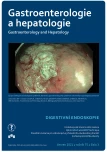Anal intraepithelial neoplasia and HD anoscopy
Authors:
Procházka R.
Authors‘ workplace:
Oddělení gastroenterologie, Nemocnice Jablonec nad Nisou, p. o.
Published in:
Gastroent Hepatol 2021; 75(3): 229-233
Category:
Original Article
doi:
https://doi.org/10.48095/ccgh2021229
Overview
Anal intraepithelial neoplasia (AIN) is a precursor lesion of anal squamous cell cancer (aSCC). aSCC is considered a rare cancer, but its incidence is on the rise and in certain high-risk populations it approaches the incidence of colorectal cancer. Although controlled randomized trials are lacking, expert opinions support screening and therapy of this anal neoplasia in the high-risk groups. AIN/aSCC belongs among neoplasia associated with HPV infection. Individuals with a higher AIN/aSCC risk can be examined by rectal smear for cytology or more sensitive HPV DNA, not unlike the cervical cancer screening. In the case of a positive result, high-resolution anoscopy is recommended. However, this is not a common practice. The goal of this study is to acquaint the gastroenterology community with the not so well known AIN diagnosis and offer a new active approach to its detection and therapy. We retrospectively analyzed a cohort of 18 patients indicated for flexible anal endoscopy because of their higher risk of anal neoplasia or to explain rectorrhagia after normal colonoscopic finding. We named the anal examination with the use of flexible high-definition endoscope by the new term, high definition (HD) anoscopy. The detected lesions were removed by endoscopic mucosal resection (EMR) or biopsied and the samples sent for histopathological evaluation by one pathologist. Among 18 examined patients, AIN was diagnosed in 12 and the riskier AIN II/III was found in 7. In most cases the lesions were type IIa or Is according to Paris classifications. In all AIN cases irregularities of the mucosal IPCL vessels (intrapapillary capillary loops) were present. Based on our results we recommend active examination of the often neglected anorectal region by the flexible HD endoscope. High resolution and digital chromoendoscopic technology of modern endoscopes offers an easy way to detect and treat AIN without a risk of anal dysfunction.
Keywords:
anal intraepithelial neoplasia – human papillomavirus – squamous carcinoma anu – high-definition anoscopy
Sources
1. Minami H, Inoue H, Ikeda H et al. Usefulness of background coloration in detection of esophago-pharyngeal lesions using NBI magnification. Gastroenterol Res Pract 2012; 2012: 529782. doi: 10.1155/ 2012/ 529782.
2. Epidemiologie zhoubných nádorů v České republice. 2021 [online]. Dostupné z: http:/ / www.svod.cz.
3. Watson AJ, Smith BB, Whitehead MR et al. Malignant progression of anal intra-epithelial neoplasia. ANZ J Surg 2006; 76(8): 715–717. doi: 10.1111/ j.1445-2197.2006.03837.x.
4. Sehnal B, Zikan M, Nipcova M et al. The association among cervical, anal, and oral HPV infections in high-risk and low-risk women. Eur J Obstet Gynecol Reprod Biol X 2019; 4: 100061. doi: 10.1016/ j.eurox.2019.100061.
5. Tong WW, Jin F, McHugh LC et al. Progression to and spontaneous regression of high-grade anal squamous intraepithelial lesions in HIV-infected and uninfected men. AIDS 2013; 27(14): 2233–2243. doi: 10.1097/ QAD.0b013e3283633111.
6. Albuquerqu A. High-resolution anoscopy: unchartered territory for gastroenterologists? World J Gastrointest Endosc 2015; 7(13): 1083–1087. doi: 10.4253/ wjge.v7.i13.1083.
7. Bechara R, Inoue H. Magnifying endoscopic diagnosis of tissue atypia and cancer invasion depth in the area of pharyngoesophageal squamous epithelium by NBI enhanced magnification image: IPCL pattern classification. In: Cohen J (ed). Comprehensive atlas of high-resolution endoscopy and narrowband imaging. 2nd ed. USA: Wiley-Blackwell 2017: 49–66.
8. Roberts JR, Siekas LL, KazAM. Anal intraepithelial neoplasia: a review of diagnosis and management. World J Gastrointest Oncol 2017; 9(2): 50–61. doi: 10.4251/ wjgo.v9.i2.50.
9. Siddharthan RV, Lanciault C, Tsikitis VL. Anal intraepithelial neoplasia: diagnosis, screening, and treatment. Ann Gastroenterol 2019; 32(3): 257–263. doi: 10.20524/ aog.2019.0364.
Labels
Paediatric gastroenterology Gastroenterology and hepatology SurgeryArticle was published in
Gastroenterology and Hepatology

2021 Issue 3
- Metamizole vs. Tramadol in Postoperative Analgesia
- Metamizole at a Glance and in Practice – Effective Non-Opioid Analgesic for All Ages
- Current Insights into the Antispasmodic and Analgesic Effects of Metamizole on the Gastrointestinal Tract
- Spasmolytic Effect of Metamizole
- Obstacle Called Vasospasm: Which Solution Is Most Effective in Microsurgery and How to Pharmacologically Assist It?
Most read in this issue
- Anal intraepithelial neoplasia and HD anoscopy
- Endoscopic bariatric therapies
- A rare cause of dysphagia in adult
- Teduglutide in the treatment of short bowel syndrome in Crohn’s disease
